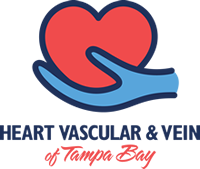At Heart, Vascular and Vein of Tampa Bay, we provide our patients with full vein care in the office by a very dedicated and capable team with full vein evaluation of the visible veins and the deep veins of the legs and treatment of superficial vein conditions with vein ablation, varicose vein removal and injection sclerotherapy. Many treatments can take as little as 15 to 30 minutes to complete and have short recovery times. Many patients can go back to their everyday activities on the day of the treatment, minimizing downtime.
Vein diseases affect more than 20 million Americans. Although some vein diseases are not life-threatening, they often cause painful and unpleasant symptoms. There is no question that vein disorders create cosmetic concern, but they may also be a sign of serious vein disease that will get worse if left untreated. Vein disease and varicose veins can cause other serious complications like Deep Vein Thrombosis (DVT) or Chronic Ulcers, when left untreated.
Symptoms can be visible such as varicose or spider veins, or they can be hidden in the form of burning, itching, swelling or night cramps. Regardless of the type of symptoms you have, it is best to seek out medical advice.
We have been providing specialized vein treatment to our patients for over ten years. We use cutting-edge technology which helps us provide the highest standard of care available.
Our comprehensive Vein Clinic services include:
Venous Doppler and Ultrasound
A Doppler ultrasound is a non-invasive test that can be used to estimate the blood flow through the blood vessels by bouncing ultrasound off circulating red blood cells. This kind of test may help diagnose conditions such as, blood clots, heart valve defects, bulging arteries, narrowing and blocking of arteries.
Stenting of Deep Veins for May Thurner syndrome
May-Thurner syndrome is a pelvic condition in which the right common iliac artery compresses the left iliac vein. A stent, which is a small, metal mesh braided tube that acts as a scaffold, is often placed during the angioplasty procedure to keep the vein open.
Treatment for leaky leg veins causing swelling and puffiness in the legs
When you have chronic venous insufficiency (CVI), the valves in the veins don’t work like they should and some of the blood may go back down into your legs. That causes blood to pool or collect in the veins. This can cause pain and swelling. Possible treatments include Sclerotherapy or endovenous thermal ablation.
Intravascular ultrasound
Intravascular ultrasound or IVUS is a diagnostic test that uses sound waves to see inside blood vessels. It is useful for evaluating the coronary arteries that supply the heart. A catheter is inserted into an artery in your groin area and moved up to the heart. A computer measures how the sound waves reflect off blood vessels, and changes the sound waves into pictures. This test gives us a look at the coronary arteries from the inside-out.
Ambulatory phlebectomy of varicose veins
Also known as microphlebectomy or stab avulsion is a technique used to remove varicose veins. This involves removing portions of varicose veins through small incisions using a hook. Stitches are generally not required and typically doe snot require a hospital stay.
Injection sclerotherapy
Sclerotherapy is a medical procedure used to eliminate spider and varicose veins. This is a very common treatment for small varicose veins. This procedure involves injecting a solution directly into the vein, forcing blood to reroute through healthier veins.
Radiofrequency ablation
Radiofrequency ablation is a minimally invasive treatment for varicose veins. In this procedure, the doctor uses heat to make a scar tissue. This scar tissue closes the vein. This technique uses radiofrequency energy to generate the heat to form a scar tissue inside the vein. This usually closes off a varicose vein in the leg.
Embolectomy of veins
This is used to remove a blood clot from inside an artery or vein. When blood thickens and clumps to form a blood clot in one of these vessels. This clot can block the blood flow. When blood flow is blocked, nearby tissues can be damaged. removal of the clot generally involves passing a catheter through a small incision in the groin to the clot site.
